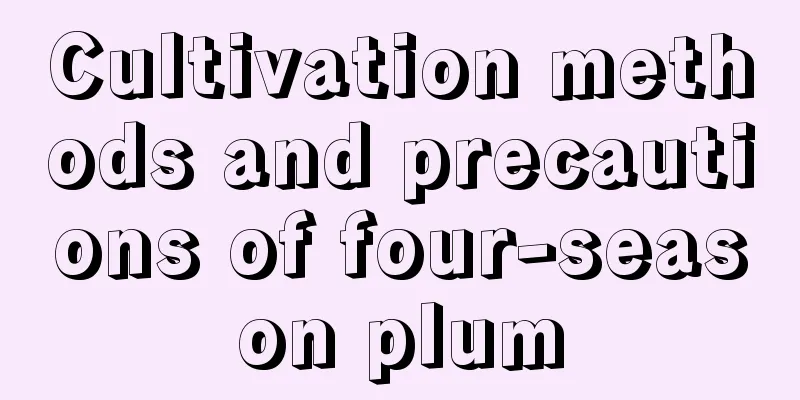Key points and techniques for fertilizing Chinese cabbage (mastering these fertilization techniques is the key)

|
Cabbage is a traditional Chinese vegetable, and autumn is an important period for cabbage planting and management. At this stage, scientific fertilization and park management should be carried out, water-soluble fertilizers should be applied reasonably, foliar fertilizers should be sprayed at the right time, and pest and disease control should be done well. These are the key points of cabbage planting. Planting Chinese cabbage and applying base fertilizerFertilization is the best way to promote crop growth during agricultural planting, and the top priority of crop fertilization management is the application of base fertilizer. The root system of cabbage grows relatively poorly, so the significance of applying base fertilizer is more prominent. The soil should be plowed and prepared before planting cabbage, and organic fertilizer must be applied heavily before the soil is plowed. It can improve soil moisture retention and air permeability, which is of great significance to promoting the growth of cabbage roots. Apply an appropriate amount of compound fertilizer before sowing cabbage. The quick-acting ingredients in the compound fertilizer can promote seed germination or wake up the seedlings, and the long-term effect of the compound fertilizer can provide sufficient nutrients for seedling growth. Fertilize Chinese cabbage regularlyCabbage mainly grows through leaves, and is relatively sensitive to nitrogen, phosphorus and potassium during the fertilization process. Base fertilizer needs to be applied before planting, and top dressing needs to be done on time after planting. Fertilization of cabbage should be determined according to the growth stage. Its growth process is divided into several stages: seedling stage, rosette stage, and heading stage. During the seedling stage, topdressing mainly uses balanced water-soluble fertilizers; during the rosette stage, farmyard manure can be selected, or microbial agents can be added. When it comes to the heading stage, cabbage's demand for fertilizer gradually increases. During this stage, topdressing is required twice, and the fertilizer content can be mainly urea, water-soluble fertilizers, etc. What fertilizer should be used before and after planting Chinese cabbage?Chinese cabbage needs to be applied with base fertilizer before planting. The base fertilizer is generally decomposed farmyard manure or finished organic fertilizer, which can loosen the soil, regulate the soil, and promote the development of the cabbage root system, providing sufficient soil fertility for later growth. After planting, Chinese cabbage needs to be fertilized regularly. Generally, balanced water-soluble fertilizer should be used for topdressing. Because the main harvestable part of cabbage is the leaves, the demand for nutrients is relatively balanced. Reasonable topdressing should be applied during the head-raising and lotus-setting stages. Generally, it is best to apply 5-10 kg of water-soluble fertilizer per acre. Fertilization tips for Chinese cabbageGrowing Chinese cabbage is relatively easy, but you must master several techniques and key points when using water-soluble materials to achieve your best. First of all, cabbage's demand for fertilizer increases continuously according to the growth nodes. The amount of fertilizer applied in the early growth stage is relatively small, and the amount of fertilizer applied in the later growth stage needs to be gradually increased. Secondly, water-soluble fertilizers have a high nutritional content, so you can apply them in small amounts and multiple times when applying them. This can avoid fertilizer damage caused by applying too much fertilizer at one time. Finally, foliar fertilizer can be sprayed regularly during the growth of cabbage, which can supplement the trace elements other than nitrogen, phosphorus and potassium and avoid physiological diseases of the cabbage . |
>>: How to increase tomato yields (how to plant and manage tomatoes for high yields)
Recommend
Are succulents still grown in pots? You are out of date. The succulents in your grandfather’s house have all grown into “old trees”!
Yes, the succulents in our impression are all sma...
Is the sudden smile the red spider lily?
What is the red spider lily? The other shore flow...
How to grow peach eggs
Growth habits of peach egg The peach egg is a suc...
How many days does it take for wheat to sprout?
Wheat is an important food crop with the advantag...
The efficacy and function of Sydney
1. Nourishes the lungs Snow pear can moisten the ...
How to grow Houttuynia cordata at home? Is Houttuynia cordata poisonous?
1. How to raise 1. Suitable light: Although Houtt...
How to grow dragon bones to make them bloom
Dragon bone blossom When the dragon bone blooms, ...
Can maple trees be planted in the north?
Can maple trees be grown in the north? Maple tree...
The efficacy and function of honeysuckle
1. Diuretic Honeydew melon has a diuretic effect,...
Can the dripping Guanyin be sown?
Seeds of the Weeping Goddess of Mercy The weeping...
How to care for the newly bought blue stone lotus
1. How to deal with the newly bought blue stone l...
Hami melon planting conditions are suitable for the climate requirements of the planting area
Introduction to Hami Melon Hami melon is a variet...
What is the difference between the large-leaved umbrella and the Schefflera arborvitae
1. The difference between leaves The leaves of th...
How to deal with root rot of white palm
1. Soil culture 1. Reduce watering Reason: Overwa...
How to propagate Hypericum by division
1. Time Propagation by division is actually very ...









